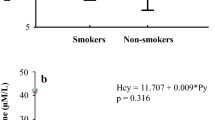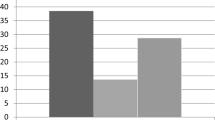Abstract
We assessed the contribution of serum homocysteine levels, an independent risk factor for vascular disease, and of the methylenetetrahydrofolate reductase (MTHFR) C677T mutation to the variability of carotid intimal-medial thickness (IMT) in patients with non–insulin-dependent diabetes mellitus (NIDDM). Ninety-five patients (33 males and 62 females, mean age 53 ± 10 years) without nephropathy or other vascular complications were enrolled. Fasting total serum homocysteine and other biochemical analytes were measured. The MTHFR polymorphism was determined by the polymerase chain reaction. Common carotid IMT and plaques or stenoses in the carotid district were measured by ultrasonography. Serum total homocysteine concentrations were higher in subjects with the mutant (Val/Val) genotype than in those with the Ala/Val plus Ala/Ala genotypes (P = 0.02). On univariate analysis, carotid IMT was significantly associated with age, body mass index (BMI), systolic blood pressure, and total cholesterolemia. No significant association was found between IMT and serum homocysteine or the MTHFR polymorphism, although a slightly greater IMT was observed in the homozygous Val genotypes. On multiple regression analysis, only age and BMI were independently associated with IMT and explained about 40% of IMT variability. The results did not change when the analysis was restricted to the subgroups with or without atherosclerotic plaques in the carotid district. In 95 Italian NIDDM patients without nephropathy, neither basal levels of serum total homocysteine nor the MTHFR C677T polymorphism predicted significant changes in common carotid intimal-medial thickness.
Similar content being viewed by others
References
Clarke R, Daly L, Robinson K, Naughten E, Cahalane S, Fowler B, Graham I. Hyperhomocysteinemia: An independent risk factor for vascular disease. N Engl J Med 1991;324:1149–1155.
Mudd SH, Levy HL, Skovby F. Disorders of transsulfuration. In: Scriver CR, Beaudet AL, Sly WS, Valle D, eds. The Metabolic Basis of Inherited Disease. 6th ed. New York: McGraw-Hill, 1995:1279–1326.
Boushey CJ, Beresford SAA, Omenn GS, Motulsky AG. A quantitative assessment of plasma homocysteine as a risk factor for vascular disease: Probable benefits of increasing folic acid intakes. JAMA 1995;274:1049–1057.
Goyette P, Sumner JS, Milos R, Duncan AMV, Rosenblatt DS, Matthews RG, Rozen R. Human methylenetetrahydrofolate reductase: Isolation of cDNA, mapping and mutation identification. Nature Genet 1994;7:195–200.
Kang SS, Wong PWK, Susmano A, Sora H, Norusis M, Ruggie N. Thermolabile methylenetetrahydrofolate reductase: An inherited risk factor for coronary artery disease. Am J Hum Genet 1991;48:536–545.
Motulsky AG. Nutritional ecogenetics: Homocysteine-related arteriosclerotic vascular disease, neural tube defects, and folic acid. Am J Hum Genet 1996;58:17–20.
Frosst P, Blom HJ, Milos R, et al. A candidate genetic risk factor for vascular disease: A common mutation in methylenetetrahydrofolate reductase. Nature Genet 1995;10: 111–113.
Kluijtmans LAJ, van den Heuvel LPWJ, Boers GHJ, et al. Molecular genetic analysis in mild hyperhomocysteinemia: A common mutation in the methylenetetrahydrofolate reductase gene is a genetic risk factor for cardiovascular disease. Am J Hum Genet 1996;58:35–41.
Gallagher PM, Meleady R, Shields DC, et al. Homocysteine and risk of premature coronary heart disease. Evidence for a common gene mutation. Circulation 1996;94:2154–2158.
Wilcken DEL, Wang XL, Wilcken B. Methylenetetrahydrofolate reductase (MTHFR) mutation, homocyst(e)ine and coronary artery disease. Circulation 1997;96:2738–2740.
Brattstrom L, Wilcken DEL, Ohrvik J, Budin L. Common methylenetetrahydrofolate reductase gene mutation leads to hyperhomocysteinemia but not to vascular disease. The result of a meta-analysis. Circulation 1998;98:2520–2526.
Colwell JA, Jokl RL: Vascular thrombosis in diabetes. In: Porte D, Sherwin R, Rifkin H, eds. Diabetes Mellitus: Theory and Practice, 5th ed. Norwalk, CT: Appleton and Lange, 1996:207–216.
King GL, Brownlee M. The cellular and molecular mechanism of diabetic complications. Endocrinol Metab Clin North Am 1996;25:255–270.
Giugliano D, Ceriello A, Paolisso G. Oxidative stress and diabetic vascular complications. Diabetes Care 1996;19: 257–267.
McCully KS. Homocysteine and vascular disease. Nature Med 1996;2:386–389.
Pastore A, Massoud R, Motti C, Lo Russo A, Fucci G, Cortese C, Federici G. Fully automated assay for total homocysteine, cysteine, cysteinylglycine, glutathione, cysteamine, and 2-mercaptopropionylglycine in plasma and urine. Clin Chem 1998;44:825–832.
Higuchi R. Simple and rapid preparation of samples for PCR. In: Erlich HA, ed. PCR Technology. New York: Stockton Press, 1989:31–38.
Pignoli P, Tremoli E, Poli A, Oreste P, Paoletti R. Intimal plus medial thickness of the arterial wall: A direct measurement with ultrasound imaging. Circulation 1986;74: 1399–1406.
Gnasso A, Irace C, Mattioli PL, Pujia A. Carotid intima-media thickness and coronary heart disease risk factors. Atherosclerosis 1996;119:7–15.
Brulhart MC, Dussoix P, Ruiz J, Passa P, Froguel P, James RW. The (Ala-Val) mutation of methylene tetrahydrofolate reductase as a genetic risk factor for vascular disease in non-insulin dependent diabetic patients. Am J Hum Genet 1997;60:228–229.
Hoogeveen EK, Kostense PJ, Beks PJ, et al. Hyperhomocysteinemia is associated with an increased risk of cardiovascular disease, especially in non-insulin-dependent diabetes mellitus: A population-based study. Arterioscler Thromb Vasc Biol 1998;18:133–138.
De Franchis R, Mancini FP, D'Angelo A, et al. Elevated total plasma homocysteine and 677C2.T mutation of the 5,10-methylenetetrahydrofolate reductase gene in thrombotic vascular disease. Am J Hum Genet 1996;59:262–264.
Motti C, Gnasso A, Bernardini S, et al. Common mutation in methylenetetrahydrofolate reductase. Correlation with homocysteine and other risk factors for vascular disease. Atherosclerosis 1998;139:377–383.
Rosolova H, Simon J, Mayer O Jr. Sefrna F. Insulin resistance and homocysteine--is there any relationship? (abstr). Atherosclerosis 1997;134:167–168.
Robillon JF, Canivet B, Candito M, et al. Type 1 diabetes mellitus and homocysteine. Diabete Metab 1994;20:494–496.
Cronin CC, McPartlin JM, Barry DG, Ferris JB, Scott JM, Weir DG. Plasma homocysteine concentrations in patients with type 1 diabetes. Diabetes Care 1998;21:1843–1847.
Wollesen F, Brattstrom L, Refsum H, Ueland PM, Berglund L, Berne C. Plasma total homocysteine and cysteine in relation to glomerular filtration rate in diabetes mellitus. Kidney Int 1999;55:1028–1035.
Voutilainen S, Alfthan G, Nyyssonen K, Salonen R, Salonen JT. Association between elevated plasma total homocysteine and increased common carotid artery wall thickness. Ann Med 1998;30:300–306.
Malinow RM, Nieto FJ, Szklo M, Chambless LE, Bond G. Carotid artery intimal-medial wall thickening and plasma homocyst(e)ine in asymptomatic adults. The Atherosclerosis Risk in Communities Study. Circulation 1993;87: 1107–1113.
Vauhkonen I, Niskanen L, Ryynanen M, et al. Divergent association of apolipoprotein E polymorphism with vascular disease in patients with NIDDM and control subjects. Diabet Med 1997;14:748–756.
Munshi MN, Stone A, Fink L, Fonseca V. Hyperhomocysteinemia following a methionine load in patients with non-insulin-dependent diabetes mellitus and macrovascular disease. Metabolism 1996;45:133–135.
Araki A, Sako Y, Ito H. Plasma homocysteine concentrations in Japanese patients with non-insulin dependent diabetes mellitus: Effect of parenteral methylcobalamin treatment. Atherosclerosis 1993;103:149–157.
Hultberg B, Agardh E, Andersson A, Brattström L, Isaksson A, Israelsson B, Agardh CD. Increased levels of plasma homocysteine associated with nephropathy, but not severe retinopathy in type I diabetes mellitus. Scand J Clin Lab Invest 1991;51:277–282.
Arai K, Yamasaki Y, Kajimoto Y, et al. Association of methylenetetrahydrofolate reductase gene polymorphism with carotid arterial wall thickening and myocardial infarction in NIDDM. Diabetes 1997;46:2102–2104.
Neugebauer S, Baba T, Kurokawa K, Watanabe T. Defective homocysteine metabolism as a risk factor for diabetic retinopathy. Lancet 1997;349:473–474.
Vaccaro O, Ingrosso D, Rivellese A, Greco G, Riccardi G. Moderate hyperhomocysteinaemia and retinopathy in insulin-dependent diabetes. Lanet 1997;349:1102–1103.
Hofmann MA, Koll B, Zunbach MS, et al. Hyperhomocyst(e) inemia and endothelial dysfunction in IDDM. Diabetes Care 1997;20:1880–1886.
Author information
Authors and Affiliations
Corresponding author
Rights and permissions
About this article
Cite this article
Mazza, A., Motti, C., Nulli, A. et al. Serum Homocysteine, MTHFR Gene Polymorphism, and Carotid Intimal-Medial Thickness in NIDDM Subjects. J Thromb Thrombolysis 8, 207–212 (1999). https://doi.org/10.1023/A:1008962220476
Issue Date:
DOI: https://doi.org/10.1023/A:1008962220476




